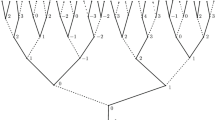Abstract
A scheme of equilibrium formation of concatamers by two different oligonucleotides has been considered. It is shown that in the general case, the dependence of the concentration of oligonucleotide components on temperature cannot be found in analytical form. Therefore, it is impossible to find the thermodynamic parameters of concatamer formation (ΔH 0, ΔS 0) and melting temperatures by analyzing the profiles of thermal denaturation of oligonucleotide complexes. An algorithm for numerical solution of implicit dependences has been developed. A number of approaches are considered that simplify the analysis of heat denaturation curves for concatamer complexes. It is shown that the dependence of the efficiency of concatamerization on temperature can be described analytically when duplex fragments have close stability and there is no cooperativity at the oligonucleotide junction. In this case, the dependence of melting temperature on thermodynamic parameters and oligonucleotide concentration has the same form as in the case of the duplex structure formed by a pair of non-self-complementary oligonucleotides. The ability of various model approaches to describe the experimental curves of concatamer heat denaturation is evaluated. For concatamer structures used as signal amplifiers in DNA hybridization analysis, a function is introduced that shows the relative contribution of a concatamer of given length to the magnitude of signal amplification. The dependence of the maximum of this function on the concentration of oligonucleotides, the thermodynamic characteristics of their complexes, and temperature has been determined. It is shown by the gel retardation assay that the function of the length distribution of concatamers qualitatively correlates with the experimental dependences.
Similar content being viewed by others
References
O. N. Simonova, A. V. Vladimirova, M. A. Zenkova, and V. V. Vlassov, Biochim. Biophys. Acta 1758(3), 413 (2006).
T. Sarkar, C. C. Conwell, L. C. Harvey, et al., Nucl. Acids Res. 33(1), 143 (2005).
S. P. Mathupala and A. E. Sloan, BMC Genomics 3(1), 20 (2002).
N. G. Dolinnaya and Z. A. Shabarova, Izv. RAN Ser. Khim. no. 8, 1889 (1996).
R. M. Dirks and N. A. Pierce, Proc Natl. Acad. Sci. USA 101(43), 15275 (2004).
M. S. Shchepinov, I. A. Udalova, A. J. Bridgman, and E. M. Southern, Nucl. Acids Res. 25(22), 4447 (1997).
J. SantaLucia Jr. and D. Hicks, Annu. Rev. Biophys. Biomol. Struct. 33, 415 (2004).
A. A. Lomzov, I. A. Pyshnaya, E. M. Ivanova, and D. V. Pyshnyi, Dokl. RAN 49(2), 266 (2006).
V. V. Demidov, M. V. Yavnilovich, B. P. Belotserkovskii, et al., Proc. Natl. Acad. Sci. USA 92(7), 2637 (1995).
D. Miyoshi, Z.-M. Wang, H. Karimata, and N. Sugimoto, Nucl. Acid Symp. Ser. no. 49, 43 (2005).
Z. A. Shabarova, N. G. Dolinnaya, S. I. Turkin, and E. S. Gromova, Nucl. Acids Res. 8(11), 2413 (1980).
S. A. Kushon, J. P. Jordan, J. L. Seifert, et al., J. Am. Chem. Soc. 123(44), 10805 (2001).
M. Durand, K. Chevrie, M. Chassignol, et al., Nucl. Acids Res. 18(21), 6353 (1990).
Handbook of Biochemistry and Molecular Biology: Nucleic Acids, Ed. by G. D. Fasman (CRC Press, 1975).
M. Petersheim and D. H. Turner, Biochemistry 22(2), 256 (1983).
K. J. Breslauer, Methods Mol. Biol. 26, 347 (1994).
R. Owczarzy, Biophys. Chem. 117(3), 207 (2005).
K. L. Berkner and W. R. Folk, J. Biol. Chem. 252(10), 3176 (1977).
D. V. Pyshnyi and E. M. Ivanova, Izv. RAN Ser. Khim. no. 7, 1057 (2002).
P. Yakovchuk, E. Protozanova, and M. D. Frank-Kamenetskii, Nucl. Acids Res. 34(2), 564 (2006).
J. Petruska and M. F. Goodman, J. Biol. Chem. 270(2), 746 (1995).
C. Cantor and P. Shimmel, Biophysical Chemistry (Mir, Moscow, 1984), Vol. 3.
A. V. Fotin, A. L. Drobyshev, D. Y. Proudnikov, et al., Nucl. Acid Res. 26(6), 1515 (1998).
Author information
Authors and Affiliations
Additional information
Original Russian Text © N.S. Filippov, A.A. Lomzov, D.V. Pyshnyi, 2009, published in Biofizika, 2009, Vol. 54, No. 3, pp. 402–417.
Rights and permissions
About this article
Cite this article
Filippov, N.S., Lomzov, A.A. & Pyshnyi, D.V. Thermodynamic description of oligonucleotide self-association in DNA concatamer structures. BIOPHYSICS 54, 280–290 (2009). https://doi.org/10.1134/S0006350909030038
Received:
Published:
Issue Date:
DOI: https://doi.org/10.1134/S0006350909030038




